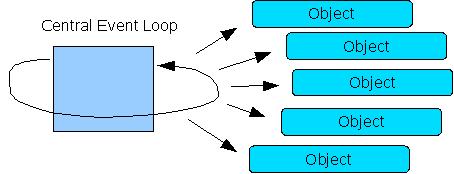Difference between revisions of "Architecture/Proposal/Advanced Threading-Architecture"
From Apache OpenOffice Wiki
m (→Cons: Category:Multi-Threading) |
m (→Problem: wording) |
||
| (One intermediate revision by the same user not shown) | |||
| Line 5: | Line 5: | ||
==Problem== | ==Problem== | ||
| − | + | A brief list of problems we face: | |
| − | * unresponsive user interface | + | * Sometimes unresponsive user interface, e.g. trying to connect to a particular web server may take some minutes, without repaint and everything (it can take more time, if you have more than one http:// reference in your document) ;-). |
| − | * | + | * Polling / busy waiting, e.g. frequent re-schedule or yield calls, while loading or saving a document. |
| − | * | + | * Scalability with multiple clients doing API calls, only one API call can be in execution at any time. |
| − | * | + | * Most long lasting operations such as loading, saving, printing etc. are not interruptible. |
==Solution== | ==Solution== | ||
| Line 35: | Line 35: | ||
Pseudo Code for event loop: | Pseudo Code for event loop: | ||
| − | < | + | <source lang="cpp"> |
void dispatch(int signal) { | void dispatch(int signal) { | ||
switch(signal) { | switch(signal) { | ||
| Line 59: | Line 59: | ||
return 0; | return 0; | ||
} | } | ||
| − | </ | + | </source> |
Graphical overview:<br> | Graphical overview:<br> | ||
Latest revision as of 11:36, 5 May 2008
Type: Proposal State: draft
The advanced threading-architecture aims to solve OOos scalability and responsiveness problems.
Contents
Problem
A brief list of problems we face:
- Sometimes unresponsive user interface, e.g. trying to connect to a particular web server may take some minutes, without repaint and everything (it can take more time, if you have more than one http:// reference in your document) ;-).
- Polling / busy waiting, e.g. frequent re-schedule or yield calls, while loading or saving a document.
- Scalability with multiple clients doing API calls, only one API call can be in execution at any time.
- Most long lasting operations such as loading, saving, printing etc. are not interruptible.
Solution
OOo must be changed to be purely event / callback driven. Please see Wikipedia for what event-driven programming is.
The following list gives a first idea, of what should be done,
- all (potentially) blocking calls need to be event-driven,
- all long lasting calls need to be executed by dedicated threads, notifying the consumers via events / callbacks, in case data is available (thus basically creating event sources and event sinks),
- UNIX asynchronous signals, being an process interface by their own, need to be mapped to events,
- Windows window messages need to be mapped to events,
- the threading-architecture must be defined high level, e.g.
- concurrency per application, or
- concurrency per document.
Pros
- Not calling potential blocking system calls leads to 'short' lasting mutex acquisitions.
- No hand crafted reschedules necessary anymore.
- Easy utilization of hyper threading, multiple cores and SMP.
- Controllable CPU utilization and possible avoidance of over utilization.
- 'Simple' architecture.
- Potentially high level thread abstraction.
Cons
- (assumed to be) Hard to implement.
Pseudo Code for event loop:
void dispatch(int signal) { switch(signal) { case SIGIO: fileHandler(getHandle()); break; case SIGTERM: ... } } int quit; sigset_t sigset; int main(void) { int signal; while(!quit) { sigwait(&sigset, &signal); dispatch(signal); } return 0; }
